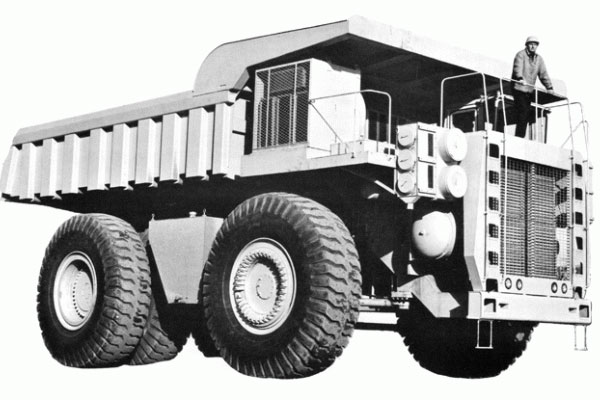
On December 4, 2019, the online auction site 4theSELLofit listed a Terex 33-15 rigid frame haul truck located in Stroud, Oklahoma. A scrapper bought it for $4,900.
Historical Construction Equipment Association (HCEA) members Eddy Larson and Rick Vosika heard about the deal, and contacted national director Larry Kotkowski. Kotkowski contacted the scrapper and was able to purchase the truck for the purpose of preserving it at the HCEA’s National Construction Equipment Museum in Bowling Green, Ohio.
This truck is an early design 33-15, serial number C-2329, with a 108-cubic-yard, 170-ton capacity box. It was shipped in February, 1974, to Kennecott Copper Co.’s Bingham Canyon Mine near Salt Lake City, Utah. It was sold to a mine in Canada and when the machine was retired, a family in Oklahoma purchased it to keep it from being scrapped. When it had to be sold, the family requested that it be moved off site for scrapping. When they found out it was going to become a permanent exhibit at the National Construction Equipment Museum, they were more than happy.
Unlike putting something in the back of a pickup or winching it onto a tilt trailer, moving a truck 26 feet wide and weighing just over 117 tons 900 miles in multiple loads is going to be no small task, especially for a non-profit. Donated trucking is being arranged, but disassembly, loading, unloading, and reassembly are going to cost money. A fundraising drive for the project has been launched. Contact the HCEA at the email address or phone number listed if you would like to assist us with this project.
In May, 1971, the Diesel Division of GM Canada Ltd. of London, Ontario, introduced the Terex 33-15 end dump, the first of several models of Terex haulers to use electric drive. It measured 41 feet 10 inches long, 20 feet 7 inches wide, and 18 feet 8 inches high. Loading height was 16 feet 1 inch.
Power was provided by a GM 16V-149T1, two-cycle, turbocharged and intercooled 16-cylinder diesel engine rated at 1,600 horsepower, or 1,445 flywheel horsepower running at 1,900 rpm. With 150 tons payload, the gross weight of the vehicle tipped the scales at just over 267 tons. With a heaped load at 2:1 the body carried 95 cubic yards.
The engine drove an AC generator, supplying current to a solid-state rectifier bank that converted AC to DC to power two drive motors in the rear axle. Unlike most electric drive trucks of that era, with motors mounted in the wheel hubs, the DC motors in the 33-15 were located in the axle, with a planetary final reduction in each wheel hub. This method was said to ease maintenance where the electric motor was separated from the gear reduction.
On December 4, 2019, an auction listing from the firm 4theSELLofit appeared online. The machine being sold was a Terex 33-15 end dump located in Stroud, Oklahoma, and it went to a scrapper for $4,900. Historical Construction Equipment Association members Eddy Larson and Rick Vosika heard about the deal, and contacted HCEA National Director Larry Kotkowski. After a conversation with the buyer, Kotkowski was able to purchase the truck from the scrapper for the purpose of preserving it at the HCEA’s National Construction Equipment Museum.
This truck is an early design 33-15, serial number C-2329, with a 108-cubic-yard, 170-ton capacity box. It was shipped in February, 1974, to Kennecott Copper Co.’s Bingham Canyon Mine near Salt Lake City, Utah. It was sold to a mine in Canada and when the machine was retired, a family in Oklahoma purchased it to keep it from being scrapped. When it had to be sold, the family requested that it be moved off site for scrapping—and when they found out it was going to become a permanent exhibit at the National Construction Equipment Museum, they were more than happy.
Unlike putting something in the back of a pickup or winching it onto a tilt trailer, moving a truck 26 feet wide and weighing just over 117 tons 900 miles in multiple loads is going to be no small task, especially for a non-profit. Donated trucking is being arranged, but disassembly, loading, unloading, and reassembly are going to cost money. A fundraising drive for the project has been launched through social media, and now the appeal is being extended across the industry. Contact the HCEA at the email address or phone number listed if you would like to assist us with this project.
Source: constructionequipment.com

